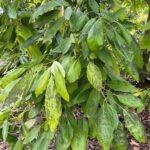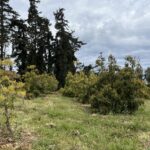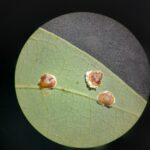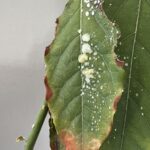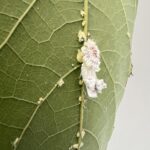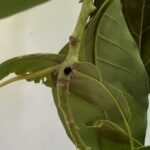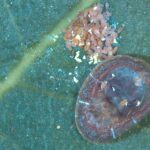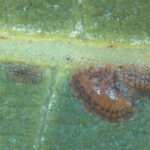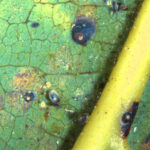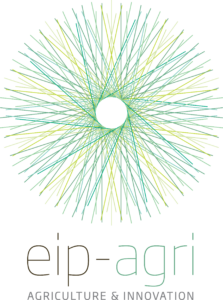Protopulvinaria pyriformis Cockerell (Hemiptera; Coccidae)
Pseudococcus longispinus Targioni-Tozzetti (Hemiptera;Pseudococcidae)
Biology
P. pyriformis is a granivorous polyphagous (≤ 150 species) and is considered as an economically important pest in many tropical regions. This insect from early stages (crawling stage) selects the site of establishment where it will complete its biological cycle. Each female can lay about 300 eggs.
Symptoms
The insect's individuals feed by sucking the plant sap at their sites of establishment, e.g. leaves, thus taking the nutrients and weakening the trees. In high populations of the insect, early defoliation, secondary tobacco infestation due to honeydew exudates, reduction in photosynthesis and crop yield may be observed.
Manage
Proper spring pruning is recommended for good ventilation and lighting inside the canopy of the tree, use of slurries or intersystemic insecticides to control the mobile stage of the insect. Adult because of the aspidium/enclosure surrounding their body (pygidium), are protected from insecticides.
Area of observation
Its presence was observed on trees of various ages in Pervolia and Platanias.
Biology
P. longispinus has a wide range of hosts (e.g. avocados, grapes, citrus fruits, pears), settling in protected areas (e.g. axillary buds) preferring warm and moist environments. It completes 2 generations/year and each female can lay 100-200 eggs.
Symptoms
The pseudococcus, like aphids, feeds by sucking the sap from leaves or tender shoots, thus extracting nutrients. In large populations of the insect, early defoliation, secondary tobacco infestation due to honeydew excretions, reduction in photosynthesis and crop yield may be observed.
Manage
Proper spring pruning is recommended for good ventilation and lighting inside the crown of the tree. Ant control to protect ants to enhance the activity of beneficial insects that fight it. It is not considered a pest of economic importance.
Area of observation
On young avocado plants in the area of Vatolakkos.
Icerya seychellarum (Westwood) (Hemiptera; Coccomorpha; Monophlebidae)
Biology
This coccoid is a polyphagous insect (ornamental houseplants, subtropical species e.g. mangoes, citrus, etc.) and was recorded on mangoes in Italy in 2019. This insect originated from infected imported planting material in Chania, but ultimately failed to establish in the aboveground plantation where it was recorded. It usually completes one overlapping generation per year.
Symptoms
It feeds by sucking the sap from the leaves (mainly on their lower surface), weakening the tree and reducing its photosynthetic capacity. From its honeydew excretions, the secondary production of the tobacco fungus contributes to further weakening the tree and reducing its photosynthetic capacity.
Manage
Appropriate pruning is recommended to reduce moisture and improve ventilation and lighting inside the crown of the tree and the use of paraffin oils or potassium fatty acid salts against mobile insect larvae.
Area of observation
Pelekapina
Coccus pseudomagnoliarum (Kuwana) (Hemiptera; Coccomorpha; Coccidae)
Biology
It is a cosmopolitan species with a wide distribution in the world. It is a polyphagous insect with the main host being citrus fruits but also other plants such as laurel, oleander, figs, etc. Probably transferred from neighbouring citrus or fig trees. It completes one generation per year. A female may lay up to 2,000 eggs in her lifetime.
Symptoms
It weakens the tree by sucking the sap from the tender vegetation as well as all the coccoids (mainly on the lower leaf surface). From their honeydewy exudates the tobacco fungus develops, which contributes to further weakening of the tree and reduction of photosynthesis.
Manage
It is not considered a major pest of avocados to date. Pruning is recommended to reduce moisture inside the crown and to provide better lighting. Paraffin oils and potassium fatty acid salts against mobile larvae.
Area of observation
Zounaki
Chrysomphalus aonidum Linnaeus (Hemiptera; Diaspididae)
Biology
It is a polyphagous species with a large number of hosts (citrus trees, fig trees, ornamentals, etc.). It prefers humid environments and is therefore usually found low in the crown, completing 4 generations on leaves and 3 generations on fruits. Probably transferred to avocado from neighbouring citrus trees.
Symptoms
It causes the weakening of trees through its feeding activity, by sucking the plant juices at its sites. It does not produce honeydew secretions.
Manage
At the moment, it is not considered a major pest of avocados . Appropriate pruning of the avocado canopy in order to achieve better ventilation and reduced humidity inside the tree canopy. Paraffinic oils and potassium fatty acid salts against the mobile larval stage.
Area of observation
Zounaki


